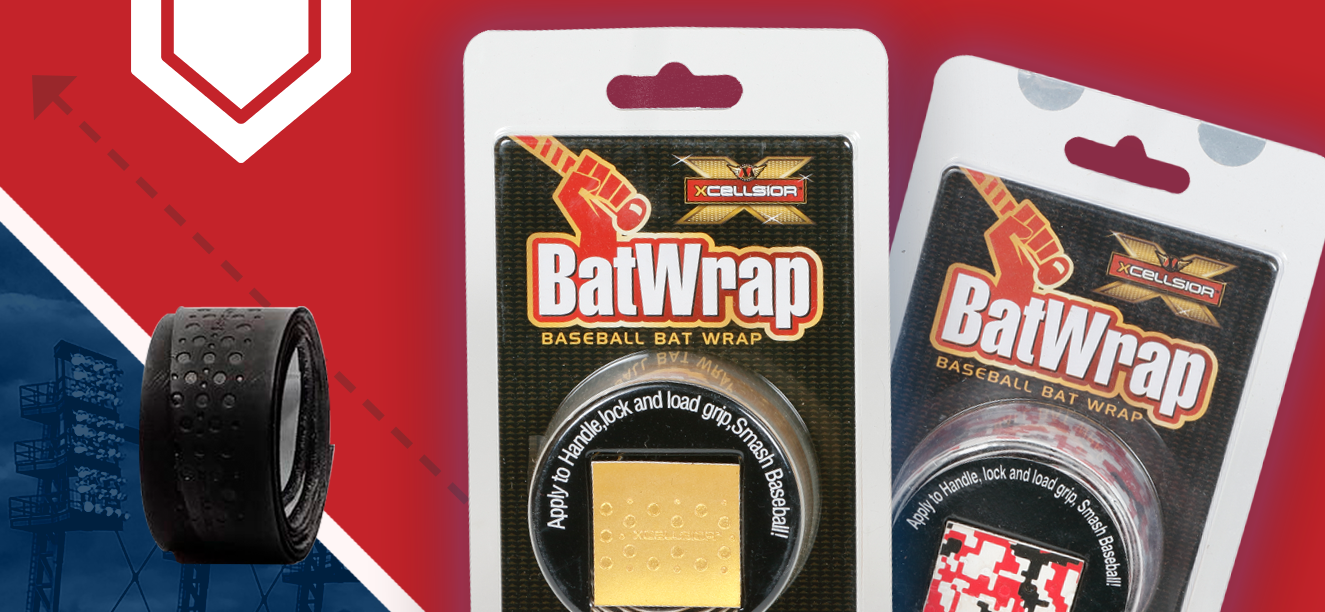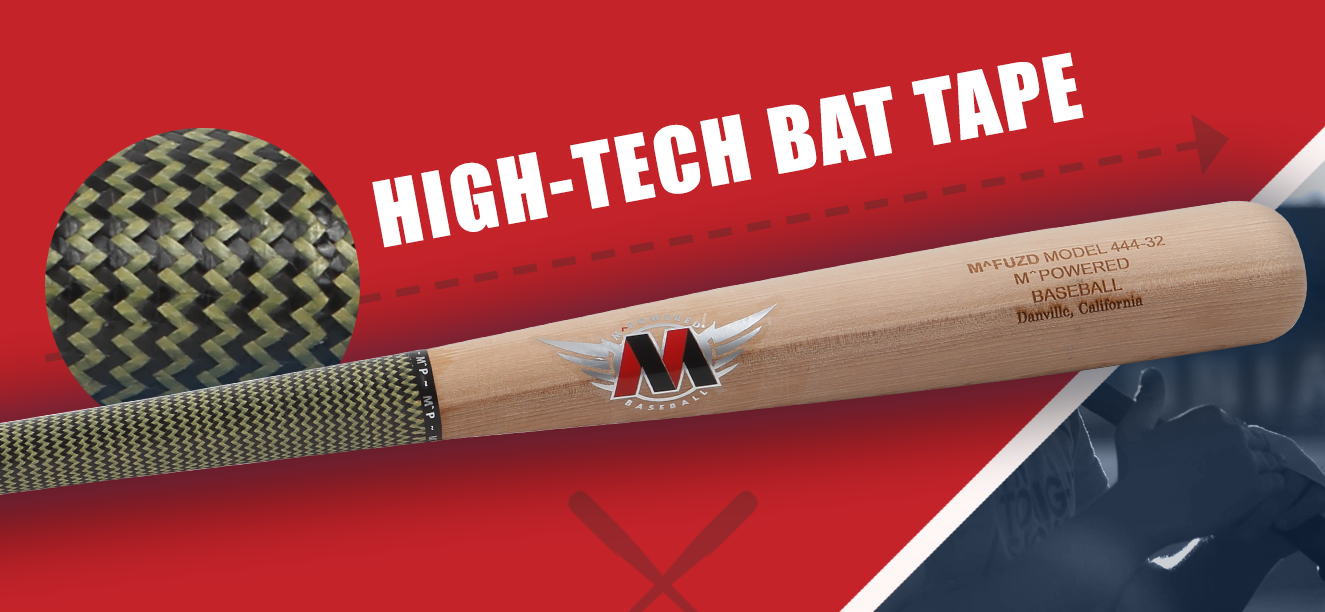BAT WRAP: A HOW-TO
Mark shows how easy it is to apply Xcellsior™ Wraps to any bat!
Shop Xcellsior™ Wrap.
Mark shows how easy it is to apply Xcellsior™ Wraps to any bat!
Shop Xcellsior™ Wrap.
It’s crucial for hitters to stay loose in between their at-bats. Because of this, it’s routine to add weight to the bat in the on-deck circle. Batters equip the classic “donut” weight, which is simply a circular piece of metal wrapped in a rubber/plastic compound, by sliding it down the handle of the bat to the midsection of the barrel. The extra weight also improves swing speed, a key to hitting dingers.
Due to the recent popularity of “sleeve” weights, the “donut” has been labeled old-school. At M^Powered Baseball, we like keeping some things old-school. Our full line of “donut” weights is available in many colors and sizes.
Grab a donut today.
Shop our bat weights.
Wood bats are typically made from nine MLB approved species. A vast majority of today’s players use maple, ash, birch, hickory, or beech. Other wood species are not readily available in billet form or squares; thus, bat makers do not use them. Up until the 1990’s, ash was the material of choice. Once Barry Bonds shattered the all-time home run record with a maple bat, maple became the wood of choice.
One of the more complicated subjects on wooden bats is their grain structure. It seems that everyone wants to be a “Professor of Woodology” these days. Here are the facts.
Maple – It’s a very hard, rigid wood that mainly grows in Pennsylvania, New York, New England, and Canada. The early maple bat models were breaking way too often, causing flying shards to strike fans, coaches, and players. The MLB hired a consultancy group to study maple. They came up with various weight and grain requirements, along with the “ink dot test” for closed grain woods. It’s a tool used for evaluating the slope of a grain to determine if the wood is “pro-grade.” The ink dot isn’t the only way to evaluate maple quality. You should also examine the wood itself. If there are strange curly grain lines, it’s a sign of poor-quality wood. You want to see a clean, uniform grain with a crisp, white color. Dark or browning areas may not be a bad thing, that simply means the piece of wood came from the area closer to the interior heartwood of the bat or from the very outside of the tree and may have some superficial bark streaks. If you see chunks of brown area, stay away – that’s most likely embedded bark. Also, always check the handle for unwanted knots. All of these factors can be attributed to birch and beech too, since they are also closed grain woods.
Ash – Make sure the grain lines run perfectly straight from the knob through end of the barrel, with no turn off or deviation. This is a key for ash bats. Another factor is the number of grain lines. In my opinion, the fewer lines the better. I’ve learned that a 7 or 8 grain ash bat will be tougher and more effective than a 15+ grain line bat. The great Tony Quinn would spend days sorting ash billets at the Louisville Slugger wood supplier looking for 6 to 9 grain ash bats – that’s all he swung. In summary, straight lines and fewer grains make for a superior ash bat.
Hickory – It’s the purest, most old-school bat material and was used during the dead-ball era. Hickory is considered to be the densest wood approved for use. It’s an open grain wood that has a tight and consistent structure. Due to its density, try to find a hickory bat that has a manageable weight.
Many of our wood bat models are available in multiple species, so hitters can choose which type of wood is right for their game.
As a longtime player and owner of a baseball company, I’ve heard numerous “best ways” to break in a new glove. You may not believe some of these, but here’s a list of the most creative techniques I’ve heard over the decades – run it over a few times with your car, soak it in vegetable oil or pig fat, microwave it, pound it with a hammer. From the ridiculous to the sublime, the list goes on and on. Here’s the M^Powered method.
First, shape the inside of the glove with your hands. Always shape it from the top down, never from side to side. This stops early onset floppy glove syndrome from occurring. Plus, top down manipulation will conform the leather to your hand to create a better bond between you and your mitt.
Next, play catch. Use the glove early and often – it’s the best way for it to take shape naturally and develop a perfect pocket. Playing catch is crucial for glove conditioning. After all, a glove is simply a tool to catch and transfer the ball to your throwing hand as fast as possible.
Lastly, we recommend to never oversaturate your glove with creams, oils or any other substances that will add weight to the mitt. We do recommend using a small amount of Pelican Glove Rub to treat the pores of the leather a few times year; preferably a month before the season and right after season’s end.
That’s how it’s done.
Most brands care more about the look of their bat grips rather than quality and feel. M^Powered Xcellsior™ bat grip is made from Durasoft® polymer that not only provides a superior feel but reduces bat vibration and other sensory issues. This means you have better control of your swing while saving your hands from that nasty sting.
Xcellsior™ bat wrap is engineered like no other. We laser-cut the main tape so the application is simple, and the adhesive is stronger. We also added a closure piece that securely holds the main section together to prevent unraveling. It lasts longer and outperforms the competition.

Xcellsior™ bat wrap is available in two sizes (1.1 mm and 0.5 mm) and 17* colorways, including patterns like camo, USA, Canada, and Puerto Rico.
So, the next time your bat grip begins to prematurely deteriorate, replace it with Xcellsior™.
Shop Xcellsior™
*0.5 mm comes in black and white only.
Wood bat handle breakage has become a part of life for hitters. We all know the drill—you buy an expensive bat at the start of the season. Soon enough, you get jammed inside or take one off the end of the barrel and snap! At that moment, you know your bat is fatally wounded.
In 2012, we began to fabricate and test materials that could improve the strength of wooden bat handles. After five years of research and development, M^FUZD™ was born.

We created a carbon fiber and Kevlar® blend that’s applied to the handle of the M^FUZD™. It’s an M^Powered exclusive and is patent pending. The reinforced handle can take over 800 pounds of spontaneous pressure before break. A typical wood bat can take about 200 pounds of pressure. The best part about this technology is that it’s perfectly legal to use. It’s considered a “high-tech bat tape” that meets all levels of wood bat requirements.
The M^FUZD™ is made with quality birch and comes in our #444 model – balanced for any style of hitter with a medium-sized barrel and handle. It’s backed with a 90-day conditional warranty.
The M^FUZD™ can handle anything thrown its way.
Shop M^FUZD™
Like most hard gear used by baseball players, batting gloves are considered a “throw away product.” This means that after a relatively short period of use, they degrade, rip, and fall apart. Then, it’s time to replace them. What a vicious cycle.
Think of it like this. Batting gloves are an incorporation of small findings of main material pieces such as plastics, synthetics, leather, thread, rubber, and applied logos. Factually, most of the iconic, big-named brands use cut-rate materials in the manufacturing of their retail grade batting gloves. They save the good stuff for the pros. Those brands rarely use leather. Instead, they use vinyl, plastic materials, or a “so-called” synthetic leather.
M^POWERED batting gloves use only tanned goatskin and lambskin with the combination of premium, four-way stretch fabric. Our sewing process utilizes strong cotton threads for construction integrity and our sizing metrics are always consistent.
The result is a high-quality, comfortable batting glove that “fits like a glove” and lasts longer than the products the big guys offer.
You have tried the rest, now try the best.
A fungo bat is a specialized bat, traditionally used by coaches. The origin of its odd name is fairly unknown and debated. Fungos are used to hit balls to fielders during practice or a while warming up before the first pitch. They are lighter and thinner than your traditional game bat. But like game bats, fungos are made out of the same types of wood such as maple, ash, birch, or beech. In some cases, they are made from poplar or bamboo, two materials that are not approved for MLB play.
Fungo bats are usually classed into infield and outfield sizes. Outfield fungos are used mostly for hitting fly balls and are offered in 34, 35, and 36-inch sizes. Infield fungos are used for hitting grounders and are usually 32 or 33 inches in length.
One recent trend I’ve been seeing around the diamond is “Fungo Golf.” It’s a fun and creative way for teammates to bond. Two or more players create makeshift golf holes around the field. Most shots are swung like a normal baseball swing, but depending on the distance, players may decide to putt. It’s scored just like golf; lowest number of strokes gets you the W.
At M^Powered Baseball, we offer a full range of fungo bats in a variety of colors and stains. As always, we will add your personal engraving free of charge.
Get your fungo on.